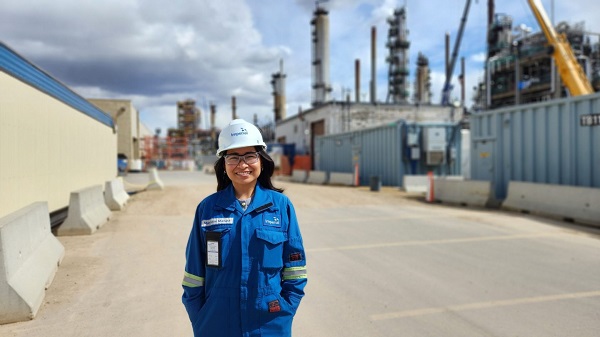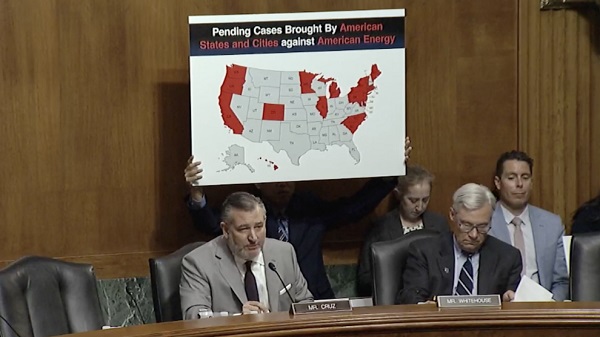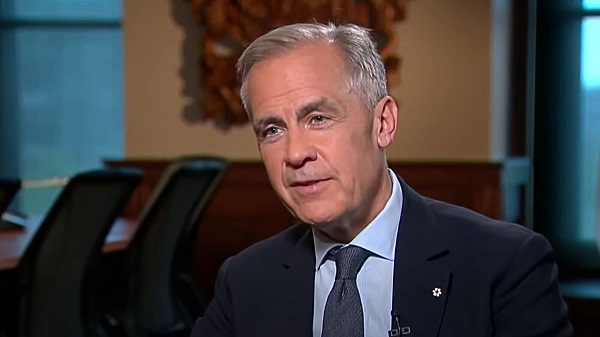Alberta
Meet Marjorie Mallare, a young woman with a leading role at one of Canada’s largest refineries

Marjorie Mallare at Imperial Oil’s Strathcona refinery.
Fr0m the Canadian Energy Centre
By Cody Ciona
Mallare manages an all-female team of engineers helping keep operations smooth and safe
As the utilities and hydroprocessing technical lead for Imperial Oil’s Strathcona Refinery near Edmonton, 32-year-old Marjorie Mallare and her team help ensure operations run smoothly and safely at one of Canada’s largest industrial facilities.
The exciting part, she says, is that all four engineers she leads are female.
It’s part of the reason Mallare was named one of ten Young Women in Energy award winners for 2025.
“I hope they realize how important the work that they do is, inspiring and empowering women, connecting women and recognizing women in our industry,” she says.
“That can be very pivotal for young women, or really any young professional that is starting off their career.”
Born and raised in the Philippines, Mallare and her family moved to Edmonton near the end of junior high school.
Living in the industrial heartland of Alberta, it was hard not to see the opportunity present in the oil and gas industry.
When she started post-secondary studies at the University of Alberta in the early 2010s, the industry was booming.
“The amount of opportunities, at least when I started university, which was around 2011, was one of the high periods in our industry at the time. So, it was definitely very attractive,” Mallare says.
When choosing a discipline, engineering stood out.
“At the time, chemical engineering had the most number of females, so that was a contributing factor,” she says.
“Just looking at what’s available within the province, within the city, chemical engineering just seemed to offer a lot more opportunities, a lot more companies that I could potentially work for.”
Through work co-ops in oil and gas, her interest in a career in the industry continued to grow.
“It just kind of naturally happened. That drew my interest more and more, and it made it easier to find future opportunities,” Mallare says.
Following a work practicum with Imperial Oil and graduation, she started working with the company full time.
On the side, Mallare has also driven STEM outreach programs, encouraging young women to pursue careers in engineering.
In addition to supporting the Strathcona Refinery’s operations department, Mallare and her team work on sustainability-focused projects and reducing the refinery’s carbon footprint.
The 200,000 barrel per day facility represents about 30 per cent of Western Canada’s refining capacity.
“Eventually, our group will also be responsible for running the new renewable diesel unit that we’re planning to commission later this year,” says Mallare.
Once completed, the $720 million project will be the largest renewable diesel facility in Canada, producing more than one billion litres of biofuel annually.
Projects like these are why Mallare believes Canada will continue to be a global energy leader.
“We’re leading others already with regards to pursuing more sustainable alternatives and reducing our carbon footprints overall. That’s not something we should lose sight of.”
Alberta
Alberta judge sides with LGBT activists, allows ‘gender transitions’ for kids to continue

From LifeSiteNews
‘I think the court was in error,’ Alberta Premier Danielle Smith has said. ‘There will be irreparable harm to children who get sterilized.’
LGBT activists have won an injunction that prevents the Alberta government from restricting “gender transitions” for children.
On June 27, Alberta King’s Court Justice Allison Kuntz granted a temporary injunction against legislation that prohibited minors under the age of 16 from undergoing irreversible sex-change surgeries or taking puberty blockers.
“The evidence shows that singling out health care for gender diverse youth and making it subject to government control will cause irreparable harm to gender diverse youth by reinforcing the discrimination and prejudice that they are already subjected to,” Kuntz claimed in her judgment.
Kuntz further said that the legislation poses serious Charter issues which need to be worked through in court before the legislation could be enforced. Court dates for the arguments have yet to be set.
READ: Support for traditional family values surges in Alberta
Alberta’s new legislation, which was passed in December, amends the Health Act to “prohibit regulated health professionals from performing sex reassignment surgeries on minors.”
The legislation would also ban the “use of puberty blockers and hormone therapies for the treatment of gender dysphoria or gender incongruence” to kids 15 years of age and under “except for those who have already commenced treatment and would allow for minors aged 16 and 17 to choose to commence puberty blockers and hormone therapies for gender reassignment and affirmation purposes with parental, physician and psychologist approval.”
Just days after the legislation was passed, an LGBT activist group called Egale Canada, along with many other LGBT organizations, filed an injunction to block the bill.
In her ruling, Kuntz argued that Alberta’s legislation “will signal that there is something wrong with or suspect about having a gender identity that is different than the sex you were assigned at birth.”
She further claimed that preventing minors from making life-altering decisions could inflict emotional damage.
However, the province of Alberta argued that these damages are speculative and the process of gender-transitioning children is not supported by scientific evidence.
“I think the court was in error,” Alberta Premier Danielle Smith said on her Saturday radio show. “That’s part of the reason why we’re taking it to court. The court had said there will be irreparable harm if the law goes ahead. I feel the reverse. I feel there will be irreparable harm to children who get sterilized at the age of 10 years old – and so we want those kids to have their day in court.”
READ: Canadian doctors claim ‘Charter right’ to mutilate gender-confused children in Alberta
Overwhelming evidence shows that persons who undergo so-called “gender transitioning” procedures are more likely to commit suicide than those who are not given such irreversible surgeries. In addition to catering to a false reality that one’s sex can be changed, trans surgeries and drugs have been linked to permanent physical and psychological damage, including cardiovascular diseases, loss of bone density, cancer, strokes and blood clots, and infertility.
Meanwhile, a recent study on the side effects of “sex change” surgeries discovered that 81 percent of those who have undergone them in the past five years reported experiencing pain simply from normal movements in the weeks and months that followed, among many other negative side effects.
Alberta
Alberta Independence Seekers Take First Step: Citizen Initiative Application Approved, Notice of Initiative Petition Issued

Alberta’s Chief Electoral Officer, Gordon McClure, has issued a Notice of Initiative Petition.
This confirms a Citizen Initiative application has been received and the Chief Electoral Officer has determined the requirements of section 2(3) of the Citizen Initiative Act have been met.
Approved Initiative Petition Information
The approved citizen initiative application is for a policy proposal with the following proposed question:
Do you agree that Alberta should remain in Canada?
The Notice of Initiative Petition, application, and statement provided by the proponent are available on Elections Alberta’s website on the Current Initiatives Petition page.
As the application was received and approved prior to coming into force of Bill 54: Election Statutes Amendment Act, the Citizen Initiative process will follow requirements set out in the Citizen Initiative Act as of June 30, 2025.
Next Steps
- The proponent must appoint a chief financial officer within 30 days (by July 30, 2025).
- Once the 30-day publication period is complete and a chief financial officer has been appointed, Elections Alberta will:
- issue the citizen initiative petition,
- publish a notice on the Current Initiatives Petition page of our website indicating the petition has been issued, specifying the signing period dates, and the number of signatures required for a successful petition, and
- issue the citizen initiative petition signature sheets and witness affidavits. Signatures collected on other forms will not be accepted.
More information on the process, the status of the citizen initiative petition, financing rules, third party advertising rules, and frequently asked questions may be found on the Elections Alberta website.
Elections Alberta is an independent, non-partisan office of the Legislative Assembly of Alberta responsible for administering provincial elections, by-elections, and referendums.
-

 Automotive2 days ago
Automotive2 days agoElectric vehicle sales are falling hard in BC, and it is time to recognize reality.
-

 Business2 days ago
Business2 days agoTrump on Canada tariff deadline: ‘We can do whatever we want’
-

 Business2 days ago
Business2 days agoEurope backs off greenwashing rules — Canada should take note
-

 Energy2 days ago
Energy2 days agoChina undermining American energy independence, report says
-

 Automotive2 days ago
Automotive2 days agoPower Struggle: Electric vehicles and reality
-

 Business22 hours ago
Business22 hours agoCanada Caves: Carney ditches digital services tax after criticism from Trump
-

 Alberta15 hours ago
Alberta15 hours agoAlberta judge sides with LGBT activists, allows ‘gender transitions’ for kids to continue
-

 Health4 hours ago
Health4 hours agoRFK Jr. Unloads Disturbing Vaccine Secrets on Tucker—And Surprises Everyone on Trump






